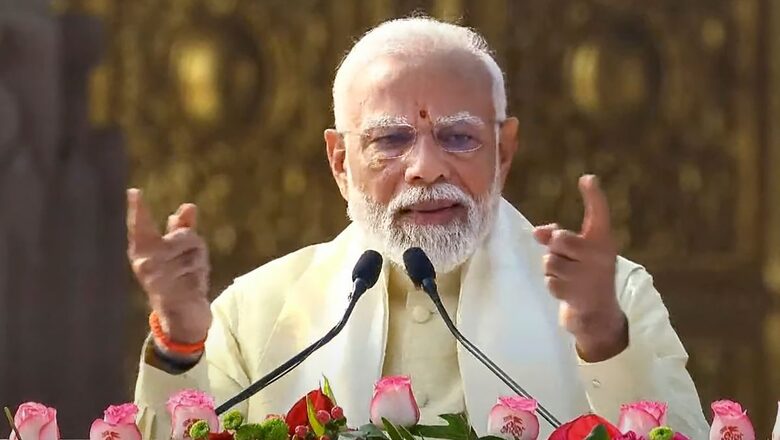
views
“Ram is not fire, Ram is energy. Ram is not a dispute, Ram is the solution. Ram is not only ours, Ram is for everyone. Ram is not just the present, Ram is eternal.” This statement by Prime Minister Narendra Modi during his speech after the consecration of Ram Lalla at Ayodhya on January 22 marks the beginning of India’s journey towards spiritual nationalism.
In the 1980s and 90s, the Bharatiya Janata Party (BJP) and Hindu nationalists talked primarily about ‘cultural nationalism’ being their goal. The concept of cultural nationalism was identified with the concept of ‘Hindutva’ propounded by Vinayak Damodar Savarkar. LK Advani, a BJP stalwart, and a leading figure of the Ram Janmabhoomi movement was the most vociferous proponent of cultural nationalism. And it became a buzzword in the public discourse primarily because of him. The quest to build a Ram Temple at Ayodhya was also equated with the ideological framework of cultural nationalism.
However, Modi’s speech at Ayodhya on January 22 has taken this concept to the next level of ‘spiritual nationalism’ as the prime minister laid it out, “this is not just a divine temple. It is a temple of India’s vision, philosophy, and direction. It is a temple of national consciousness in the form of Ram. Ram is the faith of India, the foundation of India. Ram is the thought of India, the law of India. Ram is the consciousness of India, the contemplation of India. Ram is the prestige of India, the might of India. Ram is the flow, Ram is the influence. Ram is the norm, and Ram is the policy. Ram is the permanence, and Ram is the continuity. Ram is vast, Ram is expansive. Ram is all-encompassing, Ram is the universe, the soul of the universe. And therefore, when Ram is established, its impact lasts not just for years or centuries. Its impact is for thousands of years.”
Most significantly, Modi demonstrated how to practice spiritual nationalism not merely by his words but by his actions too, as he said, “Yesterday, with the blessings of Lord Shri Ram, I was at Arichal Munai, the starting point of Ram Setu in Dhanushkodi. The moment when Lord Ram set out to cross the sea was a moment that changed the course of time. It was my humble attempt to feel the essence of that emotional moment. There, I offered floral homage. There, a belief awakened within me that just as the course of time had changed then, similarly, the course of time will change again now and will move in an auspicious direction.”
“During my 11-day fast and ritual, I attempted to touch the places where Lord Ram’s feet had trodden. Whether it be the Panchavati Dham in Nashik, the sacred Triprayar Temple in Kerala, Lepakshi in Andhra Pradesh, Ranganathaswamy Temple in Srirangam, Shri Ramanathaswamy Temple in Rameshwaram, or Dhanushkodi. I am fortunate that with this same sacred sentiment, I had the opportunity to journey from the sea to Saryu. I have had the privilege of listening to the Ramayana in various languages across the corners of the country, and especially over the last 11 days,” PM Modi further said.
Modi’s Ayodhya speech is a watershed movement in the BJP’s ideological journey also as it seems to be moving closer to Sri Aurobindo’s concept of spiritual nationalism which is much beyond the earlier framework of cultural nationalism and has the potential to be the fulcrum of Bharat’s global positioning. In fact, the move towards spiritual nationalism has been in offing for quite some time. In ancient Hindu scriptures, it has been mentioned that there are seven cities/towns which are the fountainhead of spirituality in India.
‘Kashi, Kanchi, Maya, Ayodhya, Avantika
Mathura, Dwaravati chaiva saptaita mokshadayika’
The Modi government has worked hard to revive most of these spiritual centres. Ayodhya is a major milestone and the most high-profile among them. With the consecration of Ram Lalla and the way it was celebrated in the whole country on the appeal of the prime minister, it is clear that Bharat’s journey towards spiritual nationalism, which started under the leadership of PM Modi after 2014, has taken a decisive direction on January 22 at Ayodhya. The very fact that thought leaders from all walks of society gathered for the consecration is a testament to the fact that the society at large is in consonance with Modi as far as ‘spiritual nationalism’ is concerned.
This will have a global impact too as Bharat matters in the world now and Modi gave an indication of Bharat’s emerging global view within the larger framework of spiritual nationalism as he explained how Shri Ram embodies the idea of ‘Vasudhaiva Kutumbakam’. Modi said, “Today, as the whole world is connected with the life-infusing ceremony of the Ram temple, we are witnessing the omnipresence of Ram. The celebration in India is echoed in many countries. Today’s celebration in Ayodhya has also become a festival of those global traditions of the Ramayana. This establishment of Ram Lalla is also an embodiment of the idea of Vasudhaiva Kutumbakam”.
“Today in Ayodhya, not just the idol of Shri Ram has been infused with life. It is also the life-infusion of unbreakable faith in Indian culture as represented by Shri Ram. It is the life-infusion of human values and supreme ideals. The entire world needs these values and ideals today. We have been repeating the resolution of ‘Sarve Bhavantu Sukhinah’ for centuries. Today, this resolution has taken a concrete shape in the form of the Ram temple,” he further said.
The writer is an author and columnist and has written several books. His X handle is @ArunAnandLive. Views expressed in the above piece are personal and solely that of the author. They do not necessarily reflect News18’s views.















Comments
0 comment